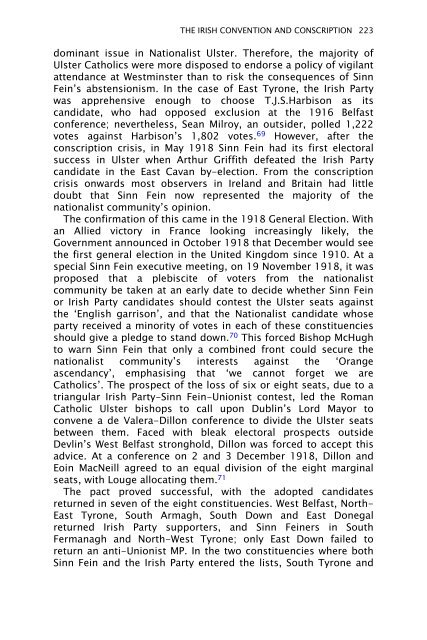Dividing Ireland: World War I and Partition
Dividing Ireland: World War I and Partition
Dividing Ireland: World War I and Partition
You also want an ePaper? Increase the reach of your titles
YUMPU automatically turns print PDFs into web optimized ePapers that Google loves.
THE IRISH CONVENTION AND CONSCRIPTION 223<br />
dominant issue in Nationalist Ulster. Therefore, the majority of<br />
Ulster Catholics were more disposed to endorse a policy of vigilant<br />
attendance at Westminster than to risk the consequences of Sinn<br />
Fein’s abstensionism. In the case of East Tyrone, the Irish Party<br />
was apprehensive enough to choose T.J.S.Harbison as its<br />
c<strong>and</strong>idate, who had opposed exclusion at the 1916 Belfast<br />
conference; nevertheless, Sean Milroy, an outsider, polled 1,222<br />
votes against Harbison’s 1,802 votes. 69 However, after the<br />
conscription crisis, in May 1918 Sinn Fein had its first electoral<br />
success in Ulster when Arthur Griffith defeated the Irish Party<br />
c<strong>and</strong>idate in the East Cavan by-election. From the conscription<br />
crisis onwards most observers in <strong>Irel<strong>and</strong></strong> <strong>and</strong> Britain had little<br />
doubt that Sinn Fein now represented the majority of the<br />
nationalist community’s opinion.<br />
The confirmation of this came in the 1918 General Election. With<br />
an Allied victory in France looking increasingly likely, the<br />
Government announced in October 1918 that December would see<br />
the first general election in the United Kingdom since 1910. At a<br />
special Sinn Fein executive meeting, on 19 November 1918, it was<br />
proposed that a plebiscite of voters from the nationalist<br />
community be taken at an early date to decide whether Sinn Fein<br />
or Irish Party c<strong>and</strong>idates should contest the Ulster seats against<br />
the ‘English garrison’, <strong>and</strong> that the Nationalist c<strong>and</strong>idate whose<br />
party received a minority of votes in each of these constituencies<br />
should give a pledge to st<strong>and</strong> down. 70 This forced Bishop McHugh<br />
to warn Sinn Fein that only a combined front could secure the<br />
nationalist community’s interests against the ‘Orange<br />
ascendancy’, emphasising that ‘we cannot forget we are<br />
Catholics’. The prospect of the loss of six or eight seats, due to a<br />
triangular Irish Party-Sinn Fein-Unionist contest, led the Roman<br />
Catholic Ulster bishops to call upon Dublin’s Lord Mayor to<br />
convene a de Valera-Dillon conference to divide the Ulster seats<br />
between them. Faced with bleak electoral prospects outside<br />
Devlin’s West Belfast stronghold, Dillon was forced to accept this<br />
advice. At a conference on 2 <strong>and</strong> 3 December 1918, Dillon <strong>and</strong><br />
Eoin MacNeill agreed to an equal division of the eight marginal<br />
seats, with Louge allocating them. 71<br />
The pact proved successful, with the adopted c<strong>and</strong>idates<br />
returned in seven of the eight constituencies. West Belfast, North-<br />
East Tyrone, South Armagh, South Down <strong>and</strong> East Donegal<br />
returned Irish Party supporters, <strong>and</strong> Sinn Feiners in South<br />
Fermanagh <strong>and</strong> North-West Tyrone; only East Down failed to<br />
return an anti-Unionist MP. In the two constituencies where both<br />
Sinn Fein <strong>and</strong> the Irish Party entered the lists, South Tyrone <strong>and</strong>








